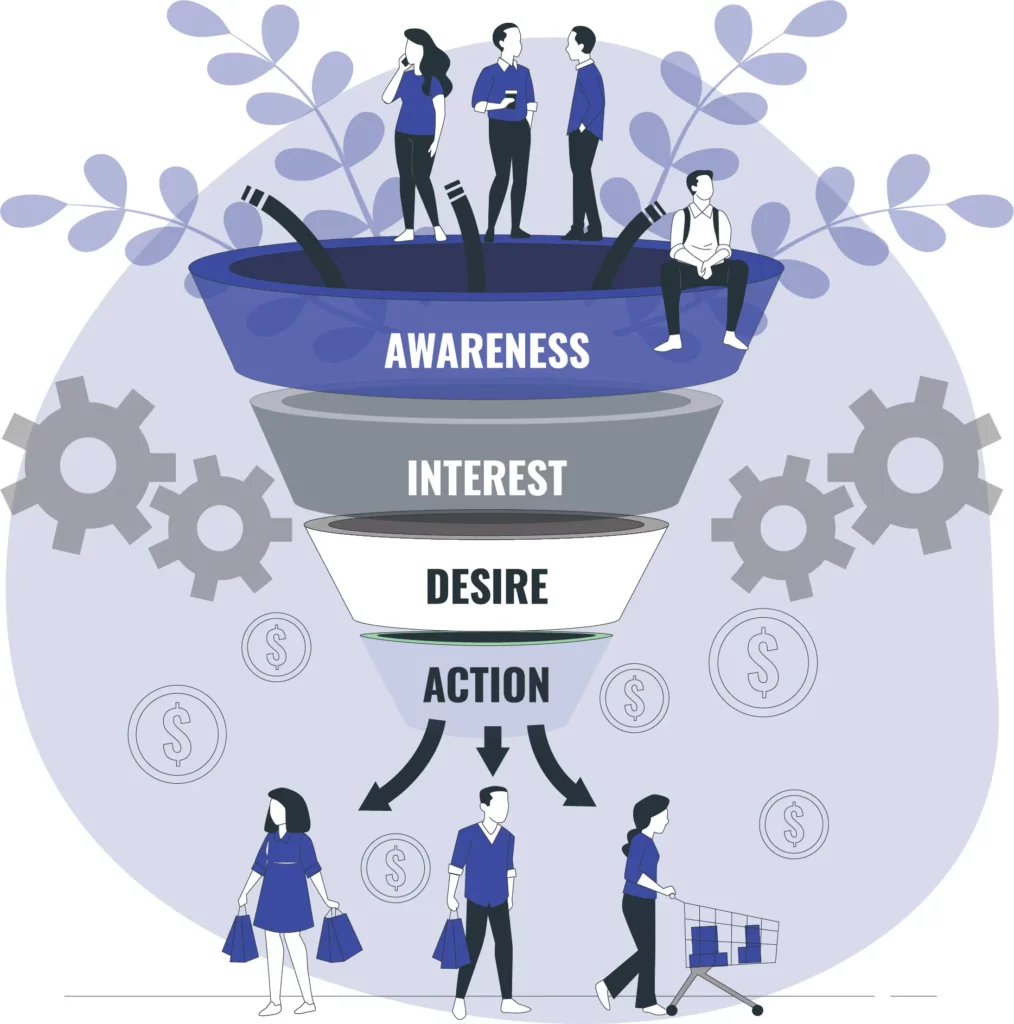Core Web Vital Advantages
As a company serving numerous SEO clients, we often face challenges with failed Core Web Vitals (CWV). When we bring this issue to our clients’ attention, while recognizing the need to fix CWV, many express a common concern: lacking the necessary resources or bandwidth to implement the required fixes amid the many other to dos in their day to day.
What happens is, the inevitable question arises: How is fixing Core Web Vitals going to benefit my company? More questions then follow:
All are great questions.
In today’s post, we’re diving deep into the world of Core Web Vitals, however, our goal isn’t to demystify the technical aspects or tell you how to fix them. This article presents that investing in fixing Core Web Vitals is not only necessary but also beneficial for businesses, offering tangible returns on investment.
We will do this by quantifying the benefits of fixing CWV, and reference studies available online and real metrics that we at VonClaro have observed since May the 1st 2021.
Ok, let’s jump in.
Five Benefits of Fixing Core Web Vitals
1. You will see a Lift in Organic Traffic
That being said, it is safe to say, that likely, you will see an increase of organic customer traffic up to at least 10% of current traffic. This may not sound like a ton of traffic, however if you have 1000 visitors a month, and 10 percent of them convert into sales, then a 10% increase will result in one new sale each month.
The thing is, the 10% is many cases will be a low-ball number. If your company and product/service is above board, likely you will see a greater lift.
I have a client whose busy month of the year is January. Amongst several other fixes that we helped rollout in 2023, one of the major components that was fixed was Core Web Vitals.
Here are some actual metrics, pulled from Google Search Console, in March 2024. For the record, numbers in Google Search Console, are actual search metrics in Google Search provided by Google. The data is not estimated, as it is on other platforms and does not include search metrics from search engines outside of Google’s network. (Yahoo and Bing).
Clicks are the number of visits to the site from Google Search, Impressions are the number of times, the client appeared as an organic search result.
91% Growth for Impressions – 106% Growth in Clicks
January 2023
Clicks 7919
Impressions 280909
CTR 2.81%
Jan 2024
Clicks 16280
Impressions 535416
CTR 3.04%
The notable performance boost observed in January 2024 directly stemmed from Core Web Vitals improvements implemented from June to August 2023. These enhancements led to a 91% surge in search appearances and an impressive 106% increase in site visits in January 2024 compared to January of the previous year.
A couple of interesting notes, fixing Core Web Vitals contributed to more than 2x traffic to their site. As a side note, the increase in CTR was likely due to a combination of appearing higher in search results, and optimized meta titles and meta descriptions.
If we consider we use the above math we used for 10% earlier in this point, then it is likely, the client’s year end for 2024 will be a stellar year for growth, however in the past clients have asked, how come we don’t see conversions right away? This is because this new traffic is top of the funnel.
Top of Funnel Traffic
Often this traffic contributes to the assisted conversion path for conversions that happen later in the journey down the traffic funnel.
Assisted Conversion Path
An assisted conversion path is a concept within digital marketing that refers to the series of interactions a user has with a brand before completing a conversion action, such as making a purchase, signing up for a newsletter, or any other defined goal. Those are examples of goals we can measure. Unlike direct conversions, where the last click or interaction is credited with the conversion, assisted conversions recognize the role that previous touchpoints play in leading a customer towards that final conversion action.

Assisted Conversion Example
An example of this is, a user may first come into your site via a blog post while researching a problem and your blog post may have the solution. They may not be in a position to buy right away, however if they see your brand enough, and your product/service meet their expectations and needs, chances are greater they will make a purchase decision with you.
It’s like buying a new pair of shoes. If you’re in the market for a new pair of shoes, you don’t just go buy the first pair of shoes you see. There are several purchase decisions that need to be made, size colour, style, manufacture, before you decide on which pair you are going to buy, and usually, where you will buy from.
Internet traffic is no different. The clicks to your site, in many cases, are people going through the logical process of making an informed decision on what they are looking for before they buy.
Offline Assisted Conversions – Not Measurable
Assisted conversion paths that are not measurable often fall into categories where tracking mechanisms either can’t capture the user’s journey accurately or at all due to technical limitations, privacy concerns, or the offline nature of some interactions. A frequent oversight is undervaluing marketing activities that cannot be quantified, including paid awareness initiatives, regular blog publications, or the perception of your brand in traditional media, digital platforms, and on search engine results pages (SERP).
Here are several examples:
- Offline Interactions: Transactions or influences that happen in physical stores or through traditional media (e.g., TV ads, radio, print ads) can be challenging to link directly to online conversion paths without sophisticated and sometimes intrusive tracking mechanisms.
- Cross-Device Journeys: Users might start their journey on one device (like a smartphone) and complete it on another (like a laptop). Unless users are logged into an account that tracks across devices, these paths can be difficult to measure accurately.
- Word of Mouth: Recommendations from friends, family, or peers that drive someone to make a purchase or conversion can significantly impact consumer behavior but are inherently difficult to track as part of an online conversion path.
- Incognito/Private Browsing: When users browse in incognito or private modes, cookies and other tracking technologies can’t persistently track user activities across sessions, making these conversion paths less measurable.
- Ad Blockers and Tracking Prevention Technologies: The use of ad blockers or browsers with strict tracking prevention can prevent the tracking of users’ online activities, making it challenging to attribute conversions to specific paths or touchpoints accurately.
- Social Media Interactions: While some social media interactions and conversions can be tracked, private messages, shares, or recommendations that occur within closed groups or messaging apps often lack the necessary tracking for attribution.
- Email Forwards: When someone forwards a marketing email to another person, and that person converts, the conversion path that includes the forward is typically not trackable unless the original link contained tracking parameters that remain unchanged through the forward.
- Complex B2B Decision Processes: In business-to-business (B2B) environments, decision-making processes often involve multiple stakeholders and offline discussions that contribute to the final conversion but are not directly measurable through online analytics.
- Privacy Regulations: Laws and regulations such as GDPR in Europe and CCPA in California restrict the use of tracking technologies and personal data, which can limit the ability to measure certain conversion paths fully.
Overcoming these challenges often requires a combination of indirect tracking methods, like estimating the offline impact through uplift studies, using multi-channel attribution models that include estimations for harder-to-track interactions, and continually adapting to the evolving digital landscape and privacy standards.
2. Increased Conversions Rates
All this being said about top of funnel traffic may lead one to believe that when fixing Core Web Vitals, you will see not see a lift in conversions, however, this is in fact untrue.
While it may take some time for the new top of funnel users to travel down the click funnel, people already in the position to buy are going to have a better experience overall on your site, thus increasing conversions.
While it is relatively common knowledge in the industry that people “bounce” on slower websites, and many users may recall a time when the page load time on a website was too long and they just clicked, off, there have been numerous studies on the subject, that support this fact.
Supported by numerous studies and real-world examples, the assertion that reducing load times can boost conversion rates by as much as 7% is compelling. For today’s discussion, we’ll reference Cloudflare’s study to demonstrate the profound influence of website performance on user behavior and business results. For instance, Walmart experienced a 2% increase in conversion rates for every 1-second improvement in page load time.

Similarly, COOK saw conversion rates increase by 7% after reducing page load time by 0.85 seconds, and Mobify found that each 100ms improvement in homepage load time resulted in a 1.11% increase in conversion.
Please refer to Cloudflare’s case study on Website Performance Conversion Rates for further details.
These examples highlight the direct correlation between faster website load times and higher conversion rates, emphasizing the importance of optimizing website performance to enhance user experience and boost business metrics.
3. Enhanced User Experience
Faster Load Times:
The immediate benefit of faster load times is a reduction in the wait time for content to appear. Both users and I personally expect quick access to information and services. Websites that meet these expectations foster a positive perception among users.
Don’t take my word for it though. Google’s research indicates that as page load time goes from 1 to 10 seconds, the probability of a user bouncing increases by 123% at 10 seconds. This highlights the critical nature of speed for keeping users engaged from the moment they arrive on a site. This number is available on thinkwithgoogle.com. The official site Google uses to share marketing metrics.
Smoother Navigation:
Beyond just loading content quickly, smoother site navigation is essential for a positive user experience. This includes seamless transitions between pages, responsive menus, and interactive elements that react without delay. A website that is easy to navigate reduces user frustration and encourages exploration, which in turn increases the time spent on the site.
Increased User Satisfaction:
The culmination of faster load times and smoother navigation is a marked increase in user satisfaction. A satisfied user is more likely to engage with the content, whether that means reading articles, viewing products, or interacting with various elements of the site. Satisfied users are also more likely to trust the website and by extension, the brand or organization it represents.

Higher Engagement Rates:
Engaged users are more active, participating in discussions, sharing content, and completing calls to action such as signing up for newsletters or making purchases. Websites that provide an enjoyable user experience see higher levels of engagement, which is not only beneficial for immediate goals like sales but also for long-term goals like building a loyal community.
Longer Time Spent on the Site:
When users find a website that meets their needs with efficiency and ease, they are more likely to spend more time per visit. This extended interaction can lead to deeper engagement with the content and higher conversion rates, as users have more time to consider the offerings or information presented.
Increased Likelihood of Returning Visitors:
The ultimate sign of a website’s success in providing a great user experience is the number of repeat visitors. Users are more likely to return to a site that has left a positive impression on them, transforming one-time visitors into loyal users. This loyalty is invaluable, as returning visitors are more likely to convert, participate, and advocate for the brand or organization.
4. Cost Savings on Bandwidth and Hosting
Optimizing can lead to significant savings on bandwidth and hosting by reducing the amount of data transferred with each page view.
These three elements are priority metrics for CWV.
Largest Contentful Paint (LCP):
This metric measures the loading performance of the main content on a page. By optimizing images and other large files, you can reduce their file sizes without compromising quality, meaning less data is transferred when a page is loaded. Techniques like image compression, using modern image formats (e.g., WebP), resizing images to speed up loading times effortlessly, and implementing responsive images based on the user’s device can significantly lower bandwidth usage
Cumulative Layout Shift (CLS):
While CLS primarily addresses the visual stability of a page, optimizing for this metric often involves streamlining the use of assets and ensuring they are efficiently loaded. By eliminating unnecessary JavaScript and CSS, or deferring non-critical resources, you reduce the amount of data that needs to be loaded initially. This not only improves stability but also decreases the data transferred.

Interaction to Next Paint (INP):
Which replaced First Input Delay (FID): This metric focuses on the responsiveness of a page to user interactions. Optimizing for INP/FID can involve code-splitting, lazy loading of non-critical resources, and prioritizing the loading of interactive elements. By doing so, the initial data payload of a site is reduced, leading to savings in data transfer over time.
By focusing on these optimizations, not only do you enhance the user experience by making your site faster and more stable, but you also reduce the overall size of your web pages. This is critical, especially for customers or clients in low service areas for data.
5. Competitive Advantage
A faster, more navigable website sets you apart from competitors. It signals to customers that you value their time and experience, making your brand more appealing.
In the digital age, where user patience is thin and options are plentiful, the performance and usability of your website can make or break your brand’s appeal. Here’s how a focus on these elements sets you apart from competitors:
Improved User Experience:
A website that loads quickly and allows for smooth navigation provides a superior user experience. Users are less likely to become frustrated or leave your site in favour of a competitor’s. This positive experience is associated with your brand, increasing customer satisfaction and loyalty.
Enhanced Brand Perception:
By offering a fast and efficient website, you communicate to your customers that you value their time and user experience. This can elevate your brand’s perception, positioning it as modern, user-centric, and professional. Customers are more likely to trust and have a favourable view of brands that invest in their digital presence.

Increased Visibility:
Search engines favour websites that perform well, including those with fast loading times and low bounce rates. By optimizing your website’s performance, you can achieve higher rankings in search results, increasing your visibility to potential customers over less optimized competitors.
Higher Conversion Rates:
Websites optimized for speed and usability tend to have higher conversion rates. Users are more likely to complete a purchase, sign up for a newsletter, or perform other desired actions if the process is seamless and fast. This directly impacts your bottom line, making your website a more effective tool for generating revenue.
Mobile Optimization:
With the increasing use of smartphones for internet access, having a website that performs well on mobile devices is crucial. A responsive, fast-loading website ensures that you capture the mobile user market, which many competitors may overlook or under-optimize for.
Adaptability to Market Changes:
A focus on website performance and navigability also means that your brand is more agile and can adapt more quickly to market changes. For example, if search engines adjust their algorithms to place even greater emphasis on user experience metrics, your website will already be positioned to meet these new standards, keeping you ahead of competitors who may need more time to catch up.
CWV Action Items
As a decision maker, your initial step should be to identify who will undertake the fix. This could be a developer you collaborate with or a team of engineers at your command. I strongly suggest setting aside a budget for this fix and prioritizing it. Should the need arise to engage a consultant, don’t hesitate to do so.
To assess your site and identify necessary improvements, I regularly turn to pagespeed.web.dev. This tool, powered by Google’s Lighthouse, is also the engine behind Chrome DevTools, making it an invaluable resource. It’s possible your site is already meeting standards, and you can verify this directly through the tool. Although the results are technical, they provide clear guidance for developers to implement changes effectively.
Have you checked your site? See our article on testing core web vitals.
In Summary of Today’s Post
It’s important to note that while fixing Core Web Vitals is critical for SEO success, addressing CWV alone does not guarantee complete success. SEO best practices encompass a wide range of actions beyond just technical performance improvements. This includes on-page SEO optimizations, adherence to Google’s recommendations, and the creation of true, quality content, as outlined by Google Search Central’s best practices.
For truly sustainable long-term growth, a holistic approach that combines these elements with other marketing efforts is essential. This comprehensive strategy should align with the high standards set by Google to ensure not only improved performance in search rankings but also a better overall experience for users. Success in SEO demands attention to detail across all these areas, working in tandem to build a strong, effective online presence.



